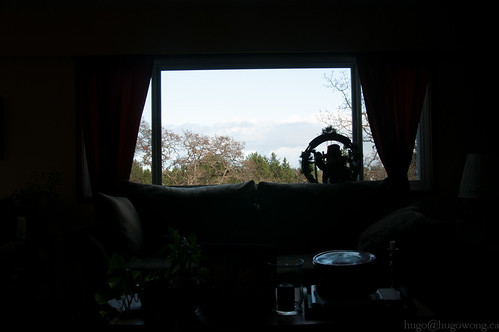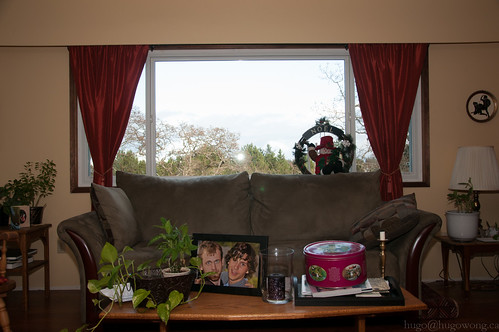Hugo Wong
Musings on photography and life on the West Coast of Canada.
Monday, October 21, 2013
Thursday, December 13, 2012
Making a Picture
When I first started shooting, I thought it strange that photographers would sometimes refer to "making pictures" rather than "taking pictures", as is the norm. For most people, photos are taken in an instant, but as any studio photographer knows, this isn't always the case, especially when you are not capturing a moment, but constructing a fantasy of sorts.
This particular photo for the Martlet was to accompany a holiday-themed article about the company of friends during the Christmas season. So, in the Strobist spirit, here's the recipe for how I made it.
First, I began by setting my camera (in this case, a Nikon D300) into 14 bit uncompressed raw shooting mode. I almost never shoot in that mode, because the file sizes are far too large and it slows the camera down to 2.5 fps, making it unacceptable slow for press use. However, in studio-type situations, I find it gives me ultimate control over the look of the final image, and smoother transitions from highlight to shadow, which is an issue for a camera that uses a sensor that dates back to 2007. I know the debate over 12 versus 14 bit is just as fierce as the anti-UV filter debate (I'll have more to say on this later) or the JPEG versus RAW debate but I'll just say that I had the card space to spare and my lonely SB-600 needs time to recycle, so I really wasn't losing anything moving into 14-bit capture in this case.
As luck would have it, my subjects left the location for about 15 minutes to run a quick errand, so I had time to fiddle with my lights in a low-pressure situation. This was ideal as my subjects could step into my light setup without waiting for me to set up, which is a luxury I don't usually get.
When I first envisioned this shot, I thought I'd have them swaddled in blankets in front of a warm fire. I would have my back to the "fire" created with a heavily gelled speedlight, and that would light their faces. When I got there, however, I found that the background was less than ideal, and I'd need to use a very wide lens to capture my three subjects, making it somewhat unflattering. I've long been uncomfortable using wides, and the widest lens I have is only 27mm, so this idea was canned immediately. So, I began to improvise...
The couch by the window provided an interesting visual, as the couch was so large it seemed to swallow the people on it. The room was awash in autumnal colours, so I decided to include the warm and inviting colours in the photograph. Even the couch featured dark wood, so it all tied in. However, the window would be a technical concern, so this ruled out an available light exposure.
Since I didn't want the window to be blown out to pure white, I sacrificed the interior light to maintain an accurate reading of the sky, and used flash to cover my tracks. I only have a single flash, a Nikon SB-600, which I trigger using the built-in flash. Yes, I could have used manual radio triggering, but like Joe McNally, I've grown quite fond of line-of-sight triggering. The fact that you can back the power up and down from the camera is absolutely essential for me, as I don't have time to adjust individual lights myself, and I don't have assistants to do it for me.
With the flash bouncing off an Impact 60" umbrella in the 45-degree position at camera right (my usual default), I made a test exposure. I have no light meter, so I'm just fudging it with the LCD. I know I shouldn't, but I don't have the money to buy a Sekonic, so I get by.
I just gave it a try at 1/16 power or something, and it was woefully inadequate, so I upped the power to something like 1/2 power. This initial test highlighted some problems I'd need to overcome.
1. The commander pulse from my pop-up flash was reflecting in the window just above the centre line of the couch, which is one of downsides of using line-of-sight triggering. I'd need to position my tallest subject in the middle so his head could block the commander pulse.
2. While the room was lit reasonably well, there was not enough light falling onto the couch. Since I only had one light, I'd need to add some on-axis fill, perhaps with my butt-ugly $10 on camera flash mod that sort of looks like a dollar-store ring flash (if dollar stores sold photo mods, that is).
3. The UV filter on my camera (an entry-level multicoated Hoya) was causing flare problems, so I had to remove it. I usually keep my UV filter welded to the front element of my lenses because I don't use lens caps (takes too much time to remove) but in this controlled studio environment, I had to maximize my image quality, which meant removing it.
I tried to deescalate by simply using ceiling bounce flash, which gave me far more light than the umbrella solution, but the light was flat and shadowless, which was not what I wanted. So, I moved back to the umbrella solution.
With my head blocking the commander pulse (the biggest problem), I could take care of the rest. My subjects returned from their errand, I had worked out enough of the kinks to feel comfortable beginning to shoot. I could solve the rest of the issues on the fly. After all, I had no choice.


What was key to the picture was my subjects relationship with each other, so I just asked them to ignore me and just talk. The situation is quite artificial, so there was some awkwardness at first, but since they were my friends, and they already knew each other, it wasn't long before they started to get more comfortable. They had ample props to occupy themselves with, like mugs, oranges, and a cat. However, the cat left after one too many camera flashes.
With the camera on a tripod and mostly static subjects, I could set the camera to manual focus at f/5.6 and just press the shutter with my eye out of the finder so I could maintain eye contact with my subjects and keep the conversation light and fast. I never used to like tripods, but I may carry one around in the future just for this reason.
At some point, I decided to add the Interfit Strobies on-camera flash diffuser, which turns on camera flash into something resembling a ring light, but costs $10. It's the perfect mod for someone who just needs a pinch of on-axis fill, and doesn't care that it is incredibly stupid looking. I had my pop-up flash set manually to something like 1/16 power, and my SB-600 at something like 1/2 power (results may vary).
I was getting a few good frames, but at the suggestion of one of the subjects, I decided to remove the coffee table from the shot. I desperately wanted to include the strange yet charming photo on the coffee table, which was why I didn't remove it in the first place, but the table was a distraction in the foreground that had to go.


After I moved the table 15 minutes into the shoot, the photo was heavily simplified, which was a very good thing. The conversation also got a lot more spirited as my subjects relaxed. The expressions suddenly became a lot more genuine, and I took advantage of the moment by pushing them a little to laugh with faux-aggression, which isn't my usual modus operandi, but given my lack of credibility as an pushy, angry person (I think), it gave me the expression that I was looking for. Though it isn't advertised as such, photography often involves making a complete fool of yourself to try and get the shot.
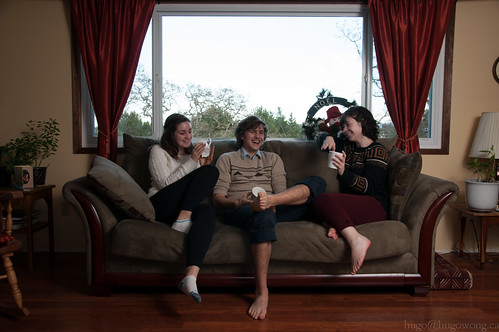

After a few more frames, I called it a day. Total time: 24 minutes including setup.
POST PROCESSING
I have never been particularly good at post, and it's something I hope to rectify in the following months with the shiny new Kelby Training subscription and NAPP membership that I picked up on Cyber Monday. However, it's for a newspaper, so it's not like I can use very advanced forms of processing anyway.
One of the serious disadvantages of manually fudging exposure without a light meter is that you're at the mercy of the inaccuracy of the LCD. While I love the 921k dot screen on the back of my D300, and I have the LCD set the -1 brightness, my manual flash images are almost invariably one stop underexposed for some reason. So, one stop of positive EV is often the first thing I plug into Lightroom. The other problem I have is that Nikon raw files are dull and lifeless. I love Nikon ergonomics, but the files it produces just aren't as appetizing to me as the Canon ones are, at least SOOC (straight out-of-camera). Hence, some sharpening, mid-tone contrast, highlight recovery on the window (I still ended up blowing out some of the highlights there), a vignette to exaggerate what was already in the photo, a slight crop to remove the errant chair leg on the left of the frame (I should have moved it out in camera, but I didn't notice at the time) and the addition of some vibrance and saturation finished the job. I don't usually saturate images this much, but it was for newsprint, which usually robs an image of saturation given the gray paper, so I think it was warranted in this case.


Look for it inside this month's issue of the Martlet, on newsstands until January 10, 2013.
Thursday, November 15, 2012
To Denver...
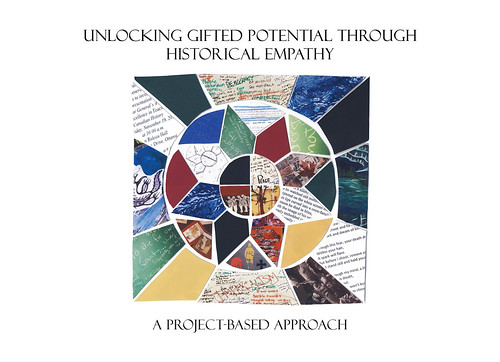
People say that it's easier to be wordy than it is to be concise. Strange, but true. This week, I found myself having to describe the Cree Star Blanket project in two short paragraphs as part of a promotional strategy. In six sentences, I had to talk people through the who, what, when, where, and why of the project. Essentially, I had to boil down my 1,400 word blog post into something that could fit on the back of a 5x7 postcard. I also got my introduction to Adobe InDesign, which I must say is a very handy program. Thanks to Will Workman who designed the postcard. I hope it's making at least a bit of a splash in in the Mile-High City. For those interested in learning more about the project, click here. For those wanting to purchase the book, click here.

Sunday, July 15, 2012
A New Project
While I wait for the initial copies of Cree Star Blanket to arrive at my doorstep for a preliminary evaluation, I’ve decided to finally start a personal project of mine that I’ve been thinking about for a few months. People like Steve Simon, Zack Arias, Chase Jarvis, and David Hobby all put a lot of emphasis on personal projects. Having just completed one, I know the feeling. That was more of a magazine piece in a hardcover book, though. The writing and the fact-finding was just as important, if not a little bit more important than the photos. There were two kinds of photos in Cree Star Blanket — photos that documented the actual project, like the mosaic or archive photos of the Chalk Talk activity (most of which were not taken by me as I could not create the book while the project was actually happening) and portraits of teachers and students that were involved with the project to provide some “faces of the project”, if you will. This time, however, I’m aiming for something that is far more skewed to photos than writing, though there will inevitably be a few sentences here and there.
So, what is this project? Well, a few months ago, I decided to see how interested my friends were in letting me document them in their personal spaces, like their offices, garages, bedrooms, etc. I sort of did a “proof of concept” a few months ago when I documented Michael’s dorm room before he dismantled it. It showed promise. I was too occupied with Cree Star Blanket to really take on another project at the same time, but I didn’t want to give up on the idea, so I’m starting it again. I might make it a series of short photo essays (one essay per subject), all focused on the idea of being young, and how different people go about it. There is not one way of being a teenager, but there is a general idea of youth that older people sort of rally around. Sometimes it’s positive, but often it’s negative. When it is positive, it’s usually just a list of accomplishments from someone labeled a wunderkind meant to give the viewer an inferiority complex. The subjects of these often “softer-than-soft” news snippets aren’t really portrayed as real, multifaceted people. I hope to go beyond that.
I might approach this like an old LIFE story, following a person around for a few hours of their day, with a majority of that time spent in the personal space that means most to them. The room/office/garage would serve as a visual anchor for the rest of the story, a repeating motif that unifies the project. I don’t think I could pull a Gene Smith and follow someone around for 3 weeks. Not yet, anyway. Somewhere in the middle of the project, I might incorporate video into it, if I feel comfortable enough with the medium (that’s after I get a dSLR that can shoot video that isn’t awful).
Do you have a personal space that you would like me to document and show to the world (on this blog or elsewhere)? Does this space have “you” written all over it? Would you mind being casually interviewed? If so, drop me a line and tell me briefly why you should be considered. I’ll be contacting a few people as well. I can’t guarantee that everyone will have a chance, but I’ll consider every entry.
Tuesday, July 3, 2012
The Book: Part Three - A Blog About A Book About A Project
At about 3 AM on July 2nd, I finished writing my first book. Well, that’s not technically true. I’ve been fiddling with minor layout issues and finding spelling errors since then, so I guess I’m not done until I send it off to the printer, but the heavy lifting was finished then. This author title doesn’t seem to fit me, though. I guess that’s what happens when you fall into stuff. See, it wasn’t even my idea. It was yet another blasted high school Social Studies project to be vanquished. It was a last hurrah, a chance to finally get high school out of my system and be comfortable with the fact that I am a second year university student. Yeah, like that was going to happen.
For those not “in the know”, I was contacted late last year by one of the great high school teachers of my life, Adrian French, who asked me to take on a project about a project, specifically to document one school project and the place that the novel Three Day Road by Joseph Boyden had in it. The actual school project is a spectacular thing, a multi-disciplinary one that incorporates student poetry inspired by the novel, the hard facts of World War One, and an enormous mosaic that serves as a way to visualize the emotions of the war as seen through the eyes of a 17-year-old high schooler, among other things.
It was French’s idea to make the book as a sort of “thank you” for Mr. Boyden. It had been kicking around in his head for a few years, and there were some attempts to get it off the ground, but to no avail. When I was approached to lead the charge, I said yes, even though I expected to be dragged through some mud for a while. After the initial excitement, I did what every good Challenge student did, and put it off. There was no firm deadline on this, so I sort of kept it in the back of my mind. I knew I wanted to do a photo-driven coffee table book right away. I just didn’t know where to go from there.
On April 19th, after I finished my last exam of my first year of university, I decided to put in the time to get this project off the ground. Some eager high schoolers, two years my junior, were tasked with helping me in this endeavor around Spring Break, but on that Thursday night, things really started to cook. That night, Celina Chan assembled a crew of overly-enthusiastic and highly intelligent Grade 11 students, and the conversation got started. For three glorious hours, a rapid fire dialogue occurred between myself and the 15-or-so members of the group. We discussed layout ideas, fonts, content to include, and everything else under the sun. That was the push I needed to get my lazy ass off the couch (the fifth season of Mad Men was in full swing, after all) and to actually do the work.
Like the war that the project chronicled, there were a few major pushes interspersed with some sitting around. In the last few weeks of June, I had realized I had spent half my summer vacation doing this, and so I redoubled my efforts to get it done so it would not consume all of it. Those last two days of June were very chaotic. I applaud those team members who answered my last minute cries for help quickly and calmly. Now that the book is finished, I’m fairly safe in assuming that no high school social studies project has ever been documented for history as painstakingly as this one. I hope this doesn’t start a precedent. I wouldn’t wish this on anyone (kidding!).
Part of the reason it took so long was because, frankly, I am not a very good writer. I sort of imagine my writing process like a manual meat grinder working through some particularly bad cut of beef. The end product should be similar in consistency to the ground beef from some big, efficient, automated meat grinder; it just took a little too much sweat to get there.
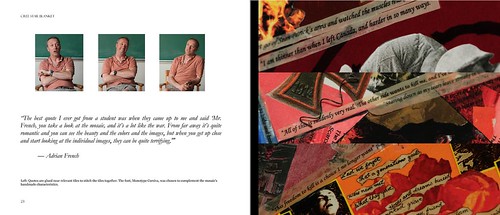

This was absolutely a labor of love. There was frustration, to be sure, but it was mostly with the Blurb-provided software. In an earlier blog post, I had mentioned the Lightroom book module, and while the templates were excellent, the inability to modify them was a dealbreaker. There are many sophisticated customization options that are available in the LR Book module, like tracking and kerning adjustment, but the inability to modify even the simplest layouts or add a text box sort of killed it for me. I guess it is meant for picture books, then, which makes sense. I guess it’s my fault for not learning InDesign earlier. I’ve never been much of a graphic designer either.
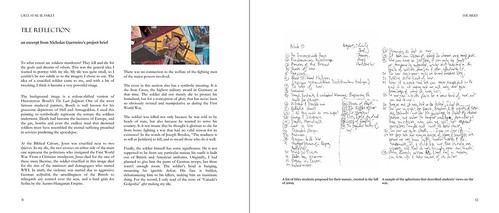

Throughout the writing process, I was very impressed with the output of these 17 year olds. After all, I had to sort through their old homework. Yes, they are still 17, and their youth does show through, but they really did think things through before putting them down on paper. Their feelings are real, and I don’t think they would have felt anything at all had Three Day Road not forced students to connect emotionally with two young soldiers (however fictional they may have been) and give them a picture of the war that doesn’t consist of a timeline with the key events and dates. It was a deafening, muddy conflict that did not treat people as people, but rather as another expendable tool of war. Reading about soldiers using broken bodies as something to reinforce the trenches with was affecting, and while it would have raised an eyebrow in a textbook, the true impact would have been lost because I wouldn’t have known that was a person with a name that I sympathized with earlier in the book. It made all the difference. I did the project once, and referred back to it numerous times throughout the writing process. It sure didn’t seem like much when I was writing it, but hindsight is always 20/20.
I tried to make the book as self-contained as possible (always a good thing), so it covers the development of the Cree Star Blanket project right up to the recognition it received in November 2010 from the Governor General of Canada. Being a photographer, I came up with the photos in my head first. I enjoyed shooting those divider photos immensely. Maybe it was because I had willing subjects. I don’t always get those.


For followers of Joe McNally, it is easy to see where I got some of my ideas from. His photos and his philosophy, particularly for The Moment it Clicks, served as the inspiration for the look and feel of the photos in my book. One foot on the coffee table and one foot in the classroom is how I envisioned it from the very beginning, only I didn’t set out to teach anyone anything. That just happened to be the setting for the photos.
I’ve always admired his ability to produce good work no matter what situation he’s dropped into, and it’s a quality that I hope to have someday. Unlike Joe (who will never live down the infamous SB-800 tree from Dubai), I had only the simplest of light setups at my disposal (one 60” umbrella and one SB-600), and I used it for every formal portrait in the book. Add a pale gold gel, my camera body, and a 35mm f/1.8 DX lens, and that was essentially it. I wanted to add some color to the book, and I couldn’t think of a better way to do it than to reveal the faces of those who did the project. The light isn’t complicated, nor should it have been.
If you’re interested in purchasing a copy for yourself to see what the fuss is all about, I’m working on it. I might put it on sale in the Blurb bookstore, or I might do something else. I’ll post about it when I figure things out. I think I’m to discuss this with Adrian over dinner this week. I think it will be the best steak I will ever have in my life.
UPDATE (11/06/2012): The book is now available for purchase as a PDF, a softcover, or as a hard cover book with dust jacket (which was how the book was intended to be read). To order a copy and to support this project, please click here.
NEW: Preview the first 15 pages of the book below. Click the full screen button for best results.
UPDATE (11/06/2012): The book is now available for purchase as a PDF, a softcover, or as a hard cover book with dust jacket (which was how the book was intended to be read). To order a copy and to support this project, please click here.
NEW: Preview the first 15 pages of the book below. Click the full screen button for best results.
Monday, June 18, 2012
The Book: Update Two

This is one of a few images I took for "the book", which is what I've taken to calling, well, the book project. Creative, right? Well, I'm not quite sure what I'm going to use it for. It thought it could be for some kind of divider page.
Once again, the 60" Impact umbrella was used, with the black backing covering half the shoot-thru to limit the spill on the background, with a pale gold gel on my SB-600. I can't remember if I used TTL flash or manual flash. I had reflectors, but once again, they proved to be useless. By default, I usually put my lights to the left of my subject, but in this instance, I wanted it to look somewhat like window light, and the windows were on the right.
The end is still not in sight for the book project. It keeps me up at night, literally. I stayed up until 3 am planning for this shoot and interview (but mostly shoot). I still have a lengthy audio interview to go over and pick juicy quotes from. However, the conversation about bra stuffing will sadly have to remain on the cutting room floor.
In other news, I've updated my 500px profile for the first time in forever, so check that out if you so desire. However, I'm rather disappointed that they're reserving the Portfolio feature for Awesome members only 19 days from now, so I'll need to reprint my business cards. I don't think I'm being vindictive when I say that they left something to be desired anyway. Maybe I'll plug away at my long-abandoned Wix site again, or just bite the bullet and join SmugMug or Zenfolio or something. In the mean time...
http://500px.com/hugowongphotography
Tuesday, June 5, 2012
Cynicism
It seems like professional photographers are under attack
from all directions. Every rent-a-cop in London seems to have a problem with
anyone holding a dSLR. The TSA released a poster
with a scary looking hooded man with a telephoto lens at an airport encouraging
people to report him. Rates are plunging because people can just hire anyone with a dSLR and a flash to run and gun for free food. That guy probably buys more fancy stuff than the pros, but doesn't have the skills. Hell, their insistence on buying the
latest and greatest camera as soon as it comes out even causes discontentment
(see NPS members griping about amateurs taking all of their D4’s and D800’s because
they needed it for their shoots while the amateurs could continue to use their
suddenly useless and incapable D3s’ for their party snaps). All these
complaints are valid. However, there seems to be a pervasive cynicism among
grizzled pros who can’t seem to make ends meet because of all these external
factors.
At the same time, people value the still photograph less and
less. I see it when a misguided bride wants a $500 wedding shooter on
Craigslist and complains that a photographer charges so much for a shoot (and
the entire photographic community inundates her inbox with angry comments
cutting her down to size). I see it when “Uncle Bob” (yes, there is a
derogatory term for pesky family members with cameras in the photog world)
insists that he can shoot it better because he’s got the latest gear and you
don’t. I see it when people say they don’t want their picture taken during a
party or something and fight you tooth and nail about it but then love it when
they see it on Facebook or Flickr, only to take the image as their own without a
word.
So, the profession isn’t perfect. It’s far from stable, and
it can provide months and years of misery. But think of it this way, we have it
pretty easy, too. Our cameras are more dependable than ever. They’re weatherproof,
tested to over 300 000 exposures, can shoot over 11 frames per second for well
over 100 frames non-stop, can shoot HD video, and provide redundancy through
multiple card slots. A single CF card can hold thousands, if not tens of
thousands, of grain free images that can be reproduced to billboard sizes. When
Jay Maisel was working, he had SIXTEEN Nikon F’s. Four cameras would be used
(with different film and lens combos, I guess), four would be for backup, four
would be in the repair shop, and four would either be going to or coming back
from the repair shop. That’s how unreliable that thing was. Even war
photographers, the bravest, hardest working, most tenacious shooters out there,
have it easier now. When Robert Capa landed with the US forces on D-Day armed
with nothing besides his balls and two Contax rangefinders, most of the film he
shot was ruined by a lab technician in London. Only eleven frames out of 106
survived that mistake. That would be unthinkable now. Images can be backed up
in minutes. Digital traces of images are everywhere, and with a little care, an
image can never really be “lost forever”, as Capa’s were.
Not only this, but there are tens of thousands of websites
dedicated to photography, dispensing free advice. You can ask a stranger for
camera advice and many people will step up and provide opinions (though they
should be taken with a grain of salt). Resources are everywhere, and you’d be a
fool not to take advantage of them.
The problems that come with being a shooter in the 21st
century are preventing a lot of people from getting better, complaining that
others are ruining the profession for them. It was hard in the 20th
century, too. If there’s a snot-nosed photog who’s consistently putting out bad
work and charging for it, eating your market share, fight by shooting better
pictures, not necessarily through lowering your prices. After all, the race to
the bottom means you’ll work harder for less money. The resulting bad feelings
mean you’ll shoot shittier pictures, and no one wants that. If you have to
charge nothing to shoot good pictures, then do that. That’s how Olivia Bee does
things. Her personal work drives her professional work. She’s hired because of
her personal work. Think a little more about the picture instead of the pixels.
Work on yourself before blaming others.
I’m not really sure who this is addressed to. I just
thought it needed to be said.
Subscribe to:
Posts (Atom)

